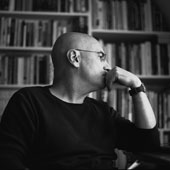As part of a week of posts celebrating the GraphicsRCA: Fifty Years exhibition, Adrian Shaughnessy interviews RCA grad, Chicago resident, and multi-talented designer James Goggin on school and study and retaining curiosity and verve in the real world.
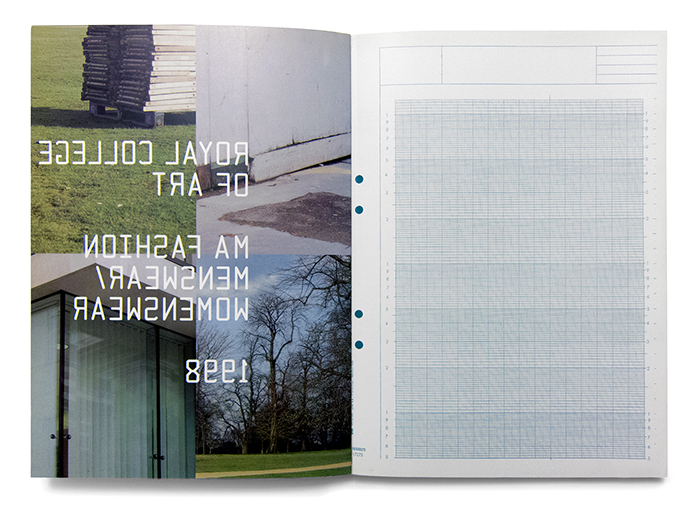
Catalogue for RCA Fashion program, Menswear/Womenswear 1998 | Royal College of Art, 1998
Adrian Shaughnessy: What prompted you to apply to the RCA?

Catalogue for RCA Fashion program, Menswear/Womenswear 1998 | Royal College of Art, 1998
Adrian Shaughnessy: What prompted you to apply to the RCA?
James Goggin: During my BA studies at Ravensbourne College of Design and Communication in the early to mid-nineties, I felt like I would benefit from a few more years of study. I knew I wanted to build a design practice that included teaching, research, and writing, and I also wanted that design practice to be an independent (or perhaps a collective) one. There were several generations of designers who I admired—from the 1960s (David Gentleman, Alan Fletcher, etc.) all the way through to the nineties (Fuel, Graphic Thought Facility, etc.)—that had passed through the RCA and worked in the ways outlined above, so it seemed a logical place for me to apply to.
Additionally, a few friends of mine were already studying there while I was in my final year at Ravensbourne, and I whenever I visited them at the College, the atmosphere there just felt right. The great library, the galleries, the incredible letterpress studio (Ravensbourne had reportedly thrown out all of their letterpress equipment a few years prior to my arrival), its location, all made the RCA an exciting prospect.
AS: What would you say is the value of postgraduate study?
JG: Time. Time for learning, reading, listening, watching, traveling. For research, exploration, discussion, debate, experimentation, production. Ideally your whole life, your career, continues to be time for all of these endeavors, but postgraduate study is a particularly luxurious and concentrated window of time. Indeed, that time can also be used to formulate a plan for the kind of practice that will continue in the spirit of postgraduate study, which is sort of how I ended up looking at it. I liked the excitement of continuous discovery, so I named my studio Practise as a kind of statement of intent (basically the opposite of “professional”; the verb practise, “practise makes perfect,” carrying out a task and learning from it), to continue my career as a deliberately perpetual student. I always remind my postgrad students of how lucky they are to have this limited amount of time for complete freedom to grow, learn, and figure out a way of continuing that growth and learning. My advice to graduating students is always the same: “Keep studying.”
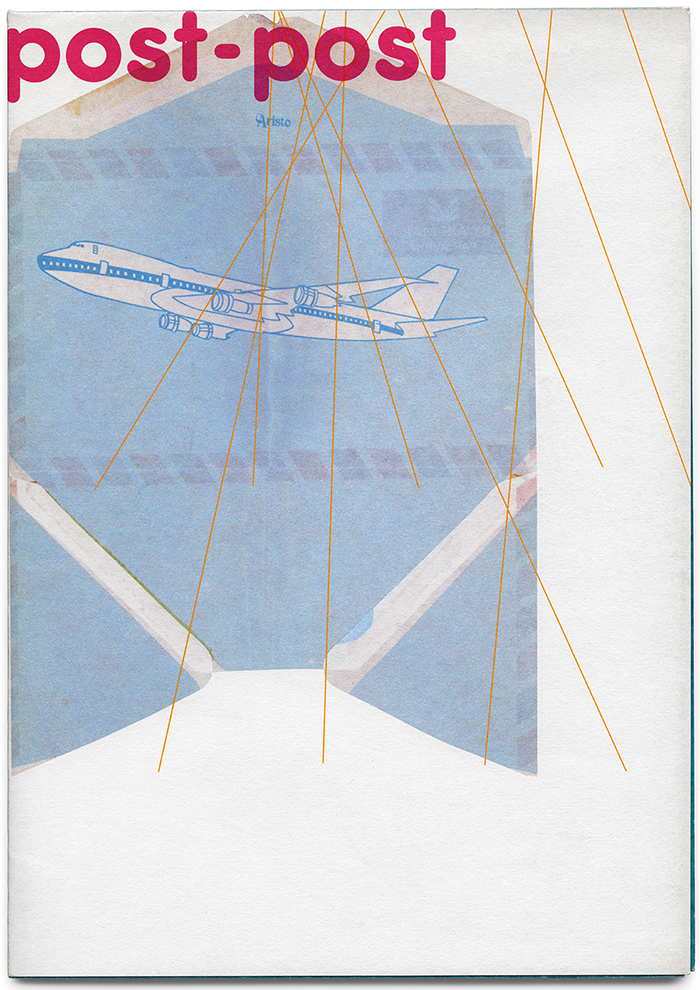
Post-Post, folded broadsheet/poster | Royal College of Art, 1999
AS: In many ways you are an archetypal RCA graduate of the 1990s, moving seamlessly from student to solo practitioner—was this always the plan, or did the possibility emerge over time?
JG: Both my undergraduate and postgraduate studies were marked by a paradoxical state where I loved studying, but at the same time wanted to already be out there in a supposed “real world,” working on “real projects,” not just class assignments printed on black and white laser printers. (Of course we all know that college is the real world too). So, while at the RCA, one of my experiments was an attempt to play out a speculative career. Already while still a student, a mix of commissioned work, self-published art projects, writing, and teaching that I hoped would define my subsequent practice. I picked up bits of work outside college, and jumped into as many RCA-related projects as I could: posters, the MA Fashion Design annual catalogue, a project with Ron Arad for the Glasgow UK City of Architecture and Design in 1999. I even started doing a bit of teaching for one term as a weekly tutor in Cambridge (the Polytechnic, I should add, not University).
So in one way, the transition was rather seamless from RCA to independent practice. On the other hand, as soon as I had the day-to-day pressures of starting a small studio and trying to remain afloat in London, I missed the time I had at the RCA to talk, read, to just sit in the library and think.
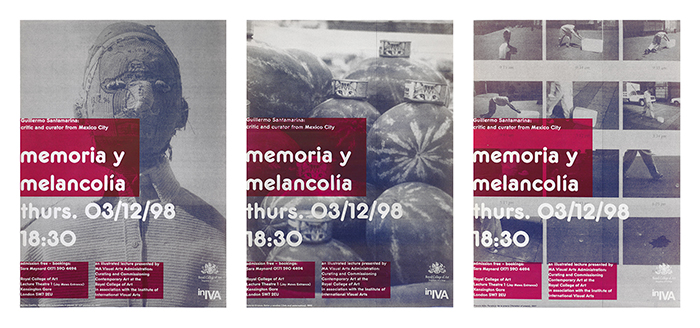
Memoria y Melancolía, poster series for RCA Curating Contemporary Art program | Royal College of Art, 1998
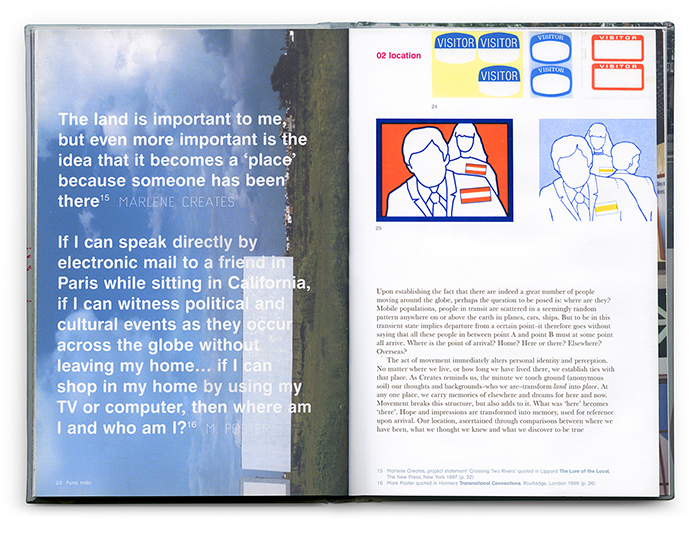
Atlas of Human Movement, thesis book | Royal College of Art, 1999
AS: How would you characterize graphic design teaching and learning when you were at the RCA?
JG: There were some great teachers at RCA when I was there, they were widely varied in their interests and specialties, and I appreciated each in their own very different way. I think figuring out which bits of advice to take from which tutors is a positive part of the education experience: it develops criticality. Some of the teachers I enjoyed were ones not officially assigned to me as a tutor: for example, I have very fond memories of just bumping into Margaret Calvert now and then, both getting on the no. 9 bus in the morning and chatting on our way to the RCA. Completely informal, and often talking about anything but graphic design. I would also definitely say that I learned equally from my student peers (from all departments) as I did from the Graphic Design and Illustration tutors.
A major thing I appreciated about the RCA, really the biggest deal for me which made it a kind of paradise, was the possibility to just roam the college, going to any lectures you liked. The French have a perfect name for this type of activity: being an auditeur libre, a “free listener.” I never knew if it was anything officially sanctioned, but I would hear about artists I liked visiting the painting department, or architects giving a talk, or a lecture about textiles in the fashion department—all things I was interested in. So I thought “why not just go to them?” even if that admittedly sometimes meant skipping the official graphic design lecture program.
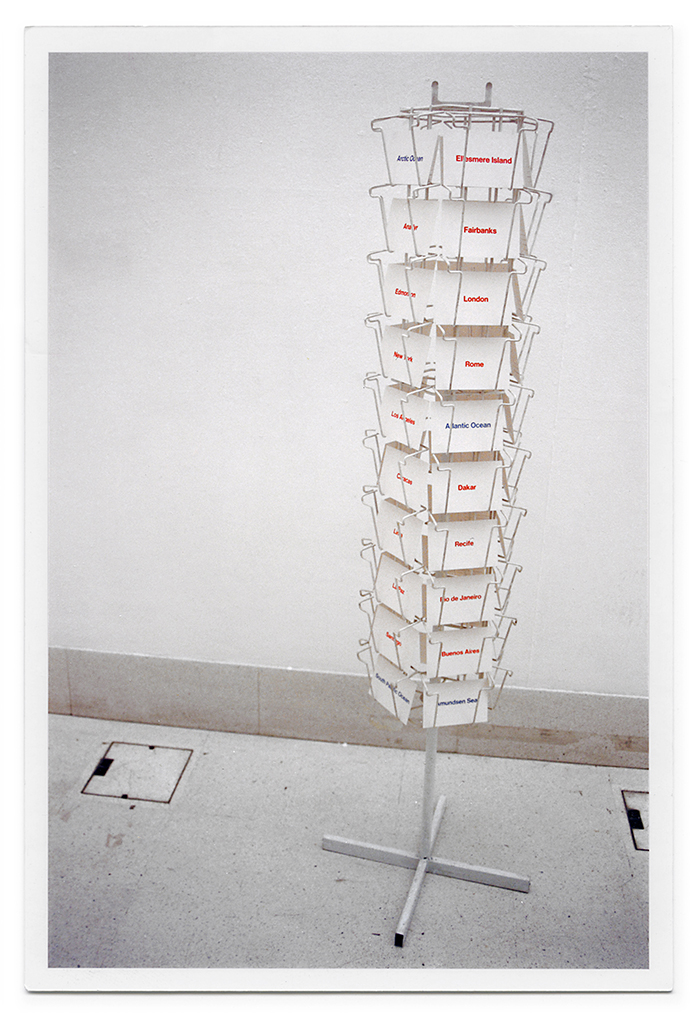
In Transit, letterpress postcard installation, 50 postcards plus found postcard display rack | Royal College of Art, 1998
AS: You will be pleased to hear that this interdepartmental activity still goes on! And since we are talking about interdisciplinarity, art practice and art theory has been highly influential amongst many RCA students–were you influenced by this?
JG: For a lot of my time at the RCA, I found myself deliberating between the idea of being an artist or a designer, or wondering if one could try and conflate the two. A lot of my projects were inspired by artists I was starting to discover at the time (Douglas Huebler, Alighiero Boetti, Francis Alÿs, Gabriel Orozco), and by some of the themes present in critical theory at the time—a lot of surveys of transnationalism, identity, sense of place, globalisation, and so on. A mix of different types of writing by Marc Augé, Zygmunt Bauman, Pico Iyer, Paul Virilio. Lucy Lippard put out her book The Lure of the Local which was hugely influential for me; Augé’s Non-Places too, and there was even an exhibition with airports, the ultimate transnational non-place, as its theme at the Photographers’ Gallery.
This tendency in contemporary art and theory at the time not only related to my own upbringing, living in six different countries, moving every two or so year, but also happened to overlap with my sister studying Anthropology at the University of Sydney while I was at the RCA. I read everything on her reading list (which included some of the aforementioned writers), and found it as equally relevant to graphic design practice as more traditional design history and theory.
The Curating Contemporary Art program at the RCA was of particular interest to me: the art scene in Mexico City was pretty hot at that point (we’re talking 1997, '98), and I was very interested in a lot of the artists and curators there (see Alÿs and Orozco mentioned above, for example). The CCA students had all gone to Mexico City on a class trip and I was really jealous, so I grilled them with questions when they got back. I’d started spotting posters in the College stairwell announcing curators I knew about from reading frieze, actually visiting to give talks, so I ended up hanging out quite a lot down there. Teresa Gleadowe, their inspiring course director, became a sort of informal mentor, recommending books to read, and I started designing posters for their talks. A lot of those students started working at galleries around London upon graduation, and that’s how I ended up working mostly in contemporary art in London, with some of them remembering me and calling me with projects here and there.
Even though I worked on a number of postal art and video projects during my two years, I always found myself wanting to design a book to document a given project, or to make a poster for a makeshift exhibition I’d set up. And I realized that ultimately it didn't have to be a choice between what was a false dichotomy anyway: “art or design.” Why curtail your interest in any number of domains due to some narrow definition of what your particular discipline should encompass? Graphic design turns out to be an ideal practice where I can work within the wide variety of fields I’m interested in: contemporary art, publishing, criticism, architecture, urbanism. Working both for and with practitioners in those areas, and often as a participant: urban studies, signage systems, editing books, curating exhibitions. I think the magpie approach to my studies at the RCA inspired me to continue working in the same way as a career.
AS: You are now a US resident, based in Chicago. How has life in America changed you and your practice?
JG: Being now situated for the time being here in Chicago, running Practise with my partner Shan James, our two daughters settled in local schools, all this was actually the result of just the kind of experiment I mentioned above.
A particular hypothesis: what would happen if I actually got a job? Something I’d vowed not to do since graduating from the RCA. The job in question being Director of Design and Publishing for the Museum of Contemporary Art Chicago. We’d already jumped into one experiment: leaving London after thinking we never would, moving us all to Arnhem and the Werkplaats Typografie in 2009 and shifting the balance of my practice more towards teaching (at WT and at ECAL in Lausanne). Then the MCA Chicago invitation came completely out of the blue and was too curious a challenge to pass up, in spite of reluctance to leave the Netherlands, which we loved.
So my practice definitely changed: from a small home studio in London to a team of eight designers, editors, project manager, web developer, and video producer. I was involved with the MCA for around three years, putting out a huge amount and variety of work with an incredible team and great curatorial and education staff there. Then I decided to take that experience, particularly the publishing side, and apply it back to independent practice again.
So that’s where we are now: we’re starting a small children’s book publishing imprint, I find myself advising clients (across the US and also still in London and Europe) on wider editorial, technological, and museological strategic issues, and although I’d term all of the above “graphic design,” I do happily also work on, well, graphic design. Posters, books, websites, finding more time for type design again now, and more writing, research, alongside regular teaching (as thesis critic at Rhode Island School of Design). Even a bit of time for reading and just thinking: basically continuing my effort to maintain the dynamic I had as a student at the RCA.

